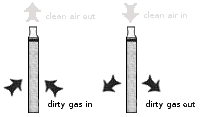Methods_of_using_fabric_filters.jpg (200 × 117 pixels, file size: 9 KB, MIME type: image/jpeg)
Schematic showing 2 methods of using fabric filters. In the book "Wie funktioniert das ? Technik heute , it appears as if the first method is mostly used for "depth filtering" and the second method is used for "surface filtering".
The first method uses fabrics as glass or artificial fiber; diameter of the fibers is 0,001mm, and the cloth is about 1mm thick. The dust collected is not used to also filter the dirty gas. Once clogged, the filters are replaced, although in some circumstances they could be cleaned with air or a liquid and reused. Speed of gasflow is about 0,1 to 3m per second.
The second method uses nonwoven fabric, ie felt, artificial fiber, glass, metal or mineral fiber; diameter of the fibers is 0,003mm to 0,03 and the cloth is several mm thick. The dust collected is used to also filter the dirty gas. Once clogged, the filters are not replaced, but are cleaned with air or a liquid and reused (cleaning is often done mechanically while the filter is still in active use). Speed of gasflow is about 0,005 to 0,1m per second.
Used image: http://en.wikipedia.org/wiki/File:Reverse_jet.jpg
File history
Click on a date/time to view the file as it appeared at that time.
| Date/Time | Thumbnail | Dimensions | User | Comment | |
|---|---|---|---|---|---|
| current | 09:47, 17 March 2011 |  | 200 × 117 (9 KB) | KVDP (talk | contribs) | Schematic showing 2 methods of using fabric filters. In the book "Wie funktioniert das ? Technik heute , it appears as if the first method is mostly used for "depth filtering" and the second method is used for "surface filtering". The first method uses |
You cannot overwrite this file.
File usage
The following page uses this file:
